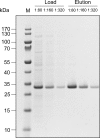Critical Analysis of the Commercial Potential of Plants for the Production of Recombinant Proteins
- PMID: 31244868
- PMCID: PMC6579924
- DOI: 10.3389/fpls.2019.00720
Critical Analysis of the Commercial Potential of Plants for the Production of Recombinant Proteins
Abstract
Over the last three decades, the expression of recombinant proteins in plants and plant cells has been promoted as an alternative cost-effective production platform. However, the market is still dominated by prokaryotic and mammalian expression systems, the former offering high production capacity at a low cost, and the latter favored for the production of complex biopharmaceutical products. Although plant systems are now gaining widespread acceptance as a platform for the larger-scale production of recombinant proteins, there is still resistance to commercial uptake. This partly reflects the relatively low yields achieved in plants, as well as inconsistent product quality and difficulties with larger-scale downstream processing. Furthermore, there are only a few cases in which plants have demonstrated economic advantages compared to established and approved commercial processes, so industry is reluctant to switch to plant-based production. Nevertheless, some plant-derived proteins for research or cosmetic/pharmaceutical applications have reached the market, showing that plants can excel as a competitive production platform in some niche areas. Here, we discuss the strengths of plant expression systems for specific applications, but mainly address the bottlenecks that must be overcome before plants can compete with conventional systems, enabling the future commercial utilization of plants for the production of valuable proteins.
Keywords: CHO cells; Pseudomonas fluorescens; cell-free biosynthesis; molecular farming; plant-made pharmaceuticals.
Figures




Similar articles
-
Plant molecular farming for the production of valuable proteins - Critical evaluation of achievements and future challenges.J Plant Physiol. 2021 Mar-Apr;258-259:153359. doi: 10.1016/j.jplph.2020.153359. Epub 2021 Jan 5. J Plant Physiol. 2021. PMID: 33460995 Review.
-
Recombinant plant-derived pharmaceutical proteins: current technical and economic bottlenecks.Biotechnol Lett. 2014 Dec;36(12):2367-79. doi: 10.1007/s10529-014-1621-3. Epub 2014 Jul 22. Biotechnol Lett. 2014. PMID: 25048244 Review.
-
Commercial aspects of pharmaceutical protein production in plants.Curr Pharm Des. 2013;19(31):5471-7. doi: 10.2174/1381612811319310002. Curr Pharm Des. 2013. PMID: 23394566
-
Opportunities for recombinant antigen and antibody expression in transgenic plants--technology assessment.Vaccine. 2005 Mar 7;23(15):1764-9. doi: 10.1016/j.vaccine.2004.11.002. Vaccine. 2005. PMID: 15734038 Review.
-
Recombinant Protein Production in Plants: A Brief Overview of Strengths and Challenges.Methods Mol Biol. 2022;2480:1-13. doi: 10.1007/978-1-0716-2241-4_1. Methods Mol Biol. 2022. PMID: 35616854 Review.
Cited by
-
Green Biologics: Harnessing the Power of Plants to Produce Pharmaceuticals.Int J Mol Sci. 2023 Dec 17;24(24):17575. doi: 10.3390/ijms242417575. Int J Mol Sci. 2023. PMID: 38139405 Free PMC article. Review.
-
Genetic Manipulation and Bioreactor Culture of Plants as a Tool for Industry and Its Applications.Molecules. 2022 Jan 25;27(3):795. doi: 10.3390/molecules27030795. Molecules. 2022. PMID: 35164060 Free PMC article. Review.
-
Innovation in plant-based transient protein expression for infectious disease prevention and preparedness.Curr Opin Biotechnol. 2020 Feb;61:110-115. doi: 10.1016/j.copbio.2019.11.002. Epub 2019 Dec 6. Curr Opin Biotechnol. 2020. PMID: 31816585 Free PMC article. Review.
-
Zika Virus Envelope Protein Domain III Produced in K. phaffii Has the Potential for Diagnostic Applications.Diagnostics (Basel). 2022 May 11;12(5):1198. doi: 10.3390/diagnostics12051198. Diagnostics (Basel). 2022. PMID: 35626353 Free PMC article.
-
Recent Developments in Bioprocessing of Recombinant Proteins: Expression Hosts and Process Development.Front Bioeng Biotechnol. 2019 Dec 20;7:420. doi: 10.3389/fbioe.2019.00420. eCollection 2019. Front Bioeng Biotechnol. 2019. PMID: 31921823 Free PMC article. Review.
References
-
- Beiss V., Spiegel H., Boes A., Kapelski S., Scheuermayer M., Edgue G., et al. . (2015). Heat-precipitation allows the efficient purification of a functional plant-derived malaria transmission-blocking vaccine candidate fusion protein. Biotechnol. Bioeng. 112, 1297–1305. 10.1002/bit.25548, PMID: - DOI - PubMed
-
- Biotechrabbit (2019a). Available at: https://www.biotechrabbit.com/rts-100-wheat-germ-kit-468.html (Accessed February 5, 2019).
-
- Biotechrabbit (2019b). Available at: https://www.biotechrabbit.com/rts-500-wheat-germ-cecf-kit-412.html (Accessed February 5, 2019).
LinkOut - more resources
Full Text Sources

